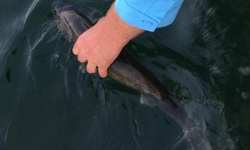ALEXANDRIA, Va. – A new study, commissioned by the Recreational Boating & Fishing Foundation (RBFF), the Bass Anglers Sportsman Society (B.A.S.S.), Fishing League Worldwide (FLW) and the Student Angler Federation (SAF) gives details on high school fishing club participation. The study, which identifies opportunity to engage new audiences in high school fishing clubs, also reveals value for fishing retailers and manufacturers.
Key report findings:
- Clubs appear to stimulate tackle sales.
- The average club member spent $658 on fishing tackle in 2018, compared to $332 for non-club members of the same age.
- Clubs appear to advance participants’ fishing skills.
- Prior to joining, on average students rated their skill at 5.6 on a scale of 1-10, and currently rate their skills at 7.7.
- Members were motivated by“fun” and “competition.”
- Club members went fishing 20 or more times in the past 12 months.
- Only 1 percent of club members had no prior fishing experience.
- 96 percent of club members reported having a family member that fishes at least once per year.
- There is an opportunity to grow and diversify these clubs.
- Highest concentration of clubs in rural/semi-rural areas of the South and Midwest.
- 93 percent of participants are male.
- 95 percent of participants are white.
- Opportunities:
- Boat clubs should consider partnering with clubs to increase access.
- Introduce clubs into urban areas to diversify club membership.
In contrast to the traditional and avid members brought in by most clubs, one program in Florida that received partial funding from RBFF’s State R3 Program Grant in 2016 could serve as a model for what clubs could strive for in the future. The Miami-Dade based program, a partnership between the Florida Fish & Wildlife Commission and FLW, brought in more novice participants (37 percent), with only 54 percent being white and 24 percent Hispanic.
“Before embarking on this project, we had a hunch that high school fishing clubs were valuable to the industry, but likely weren’t driving participation growth. This research supports that as 99 percent of participants already fished prior to joining a club,” said Frank Peterson, RBFF President & CEO. “But, that doesn’t mean there isn’t opportunity here. We see a tremendous opportunity to encourage clubs to help recruit a more diverse membership and turn those new members into lifelong anglers.”
According to Southwick Associates President Rob Southwick, who conducted the study, the biggest opportunity to tap into these clubs may be among retailers and manufacturers. “High school anglers are early adopters and have spent more money on fishing gear than their non-fishing club peers,” said Southwick. “High school anglers are influencers, having significant sway on the fishing tackle brands chosen by others of their age.”
“At a time when fishing participation is becoming increasingly diverse, these fishing clubs can become our industry’s drivers of inclusive participation on the front lines,” added Peterson.
The full report, which includes brand preferences, barriers to participation and more is available in the RBFF Resource Center.






